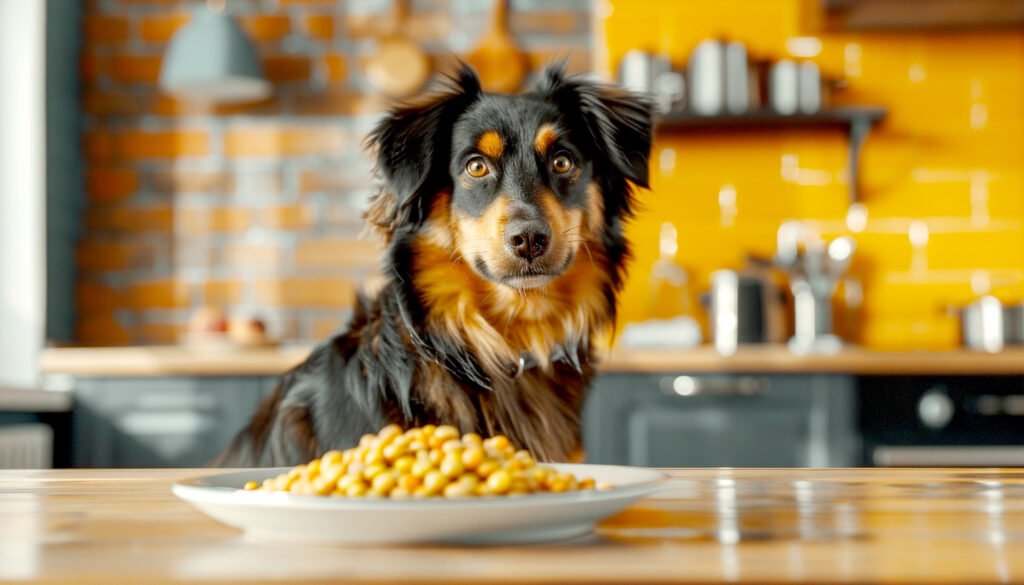With the rise of alternative diets, including those favored by vegans and vegetarians, the question of whether our furry friends should partake in these culinary trends naturally arises. Lentils, those tiny legumes well-loved for their earthy taste and nutritional punch, have found their way into many human kitchens. But what about our canine companions? Can dogs eat lentils?
In this post, we’ll explore the dietary implications of feeding lentils to dogs, weighing the potential benefits against the risks. Dog owners, pet lovers, and health-conscious consumers will get an in-depth understanding of whether lentils are safe for their pooches and what precautions they should keep in mind.
Contents
Understanding Lentils
Lentils are a type of pulse, along with beans, chicken peas, and various types of peas. They come in a rainbow of varieties, including green, red, brown, and black. Lentils are prized for their high content of fiber, protein, and minerals like iron and phosphorus, making them a staple of many vegetarian and vegan diets. They are also low in fat, making them a healthy source of energy.
Benefits of Lentils for Humans
Lentils offer many health benefits for humans. As mentioned before, they are an excellent source of fiber and protein, which can help regulate blood sugar levels and promote digestive health. Additionally, lentils contain high levels of folate, which is essential for pregnant women as it helps prevent birth defects. They are also low in calories, making them a great addition to weight-loss diets.

Can Dogs Eat Lentils?
Addressing Safety Concerns
Lentils, in moderation, can be a safe and healthy addition to your dog’s diet. They are a plant-based source of protein and can help with health concerns such as obesity by filling up your dog without the excess calories that often come with other treats. However, it is essential to be cautious and follow certain guidelines when feeding lentils to your dog.
Precautions to Keep in Mind
First and foremost, always consult with your veterinarian before making any significant changes to your dog’s diet. While lentils can provide some nutritional benefits for dogs, they should not replace a well-balanced diet specifically tailored to their needs.
So, can dogs eat lentils? The answer is yes, in moderation and with proper preparation. Lentils can provide some health benefits for dogs, but they should not replace high-quality dog food tailored to meet their nutritional needs. As with any food, it is crucial to consult with your veterinarian and introduce lentils gradually to monitor your dog’s reaction.
Potential Risks Involved
However, there are some potential downsides to consider. Lentils, if not prepared properly, can cause digestive issues, such as gas or bloating, particularly if introduced suddenly or in large amounts. Allergic reactions can also occur, although this is less common. As with any new food, it is essential to introduce lentils slowly and in small amounts to monitor your dog’s reaction. If you notice any adverse effects, stop feeding them lentils and consult with your veterinarian.

Nutritional Value for Dogs
Meeting Canine Nutritional Needs
Lentils can provide a variety of nutrients beneficial to dogs, including fiber, potassium, and folate. However, it’s essential to remember that dogs have different nutritional needs from humans, and lentils should not replace high-quality dog food designed to meet those needs. While lentils may offer some nutritional benefits, they should not make up a significant portion of your dog’s diet.
Recommended Serving Size
It is crucial to limit the amount of lentils you feed your dog, as too much can cause digestive issues and potentially lead to nutrient deficiencies. According to the Association of American Feed Control Officials (AAFCO), lentils should make up no more than 10% of a dog’s diet. This amount may vary depending on your dog’s size, age, and specific nutritional needs. Always consult with your veterinarian to determine the appropriate serving size for your dog.
Recommendations for Incorporating Lentils
If you decide to include lentils in your dog’s diet, start slow. Begin with small portions to allow your dog’s digestive system to adjust. Lentils should be cooked and not seasoned with ingredients that could be harmful to dogs, such as onions or garlic.
Nutritional Value Of Lentils:
| Amount Per 100 grams | % Daily Value* | |
| Calories | 116 | |
| Total Fat | 0.4 g | 0% |
| Saturated fat | 0.1 g | 0% |
| Cholesterol | 0 mg | 0% |
| Sodium | 2 mg | 0% |
| Potassium | 369 mg | 10% |
| Total Carbohydrate | 20 g | 6% |
| Protein | 9 g | 18% |
Potential Benefits for Dogs
Aiding in Digestion and Joint Health
For dogs with specific dietary restrictions, lentils can serve as a non-allergenic source of protein. They can also aid in digestion, as the fiber in lentils can add bulk to stools. Additionally, lentils contain choline, which is important for the health of a dog’s brain and liver. The iron in lentils can also contribute to healthy joints and muscles.
Lentils for Canine Weight Management
Given the health risks associated with obesity in dogs, lentils can be a welcome addition to a weight management plan. They can be a filling alternative to higher-calorie dog treats. However, it is essential to remember that lentils should not make up a significant portion of your dog’s diet and should be fed in moderation.
Lentils can offer some potential benefits for dogs, but they should never replace high-quality dog food designed to meet their specific nutritional needs. As with any new food, it is crucial to consult with your veterinarian before incorporating lentils into your dog’s diet and to monitor their reaction closely. When fed in moderation and prepared properly, lentils can be a safe and healthy addition to your furry friend’s meals.

Risks and Precautions
Preempting Common Digestive Issues
To avoid digestive upset, introduce lentils into your dog’s diet gradually. Monitor for any signs of discomfort, such as decreased appetite, vomiting, diarrhea, or excessive gas. If you notice any of these symptoms, stop feeding lentils and consult with your veterinarian.
Potential Allergic Reactions
While allergies to lentils in dogs are rare, it is essential to be aware of the signs and symptoms. These may include skin irritation, hives, itching, or swelling. If you suspect your dog may be allergic to lentils, discontinue feeding them and consult with your veterinarian for further guidance.
In conclusion, lentils can be a beneficial addition to your dog’s diet when fed in moderation and prepared properly. They can provide some nutritional benefits, aid in weight management, and serve as a non-allergenic source of protein. However, it is crucial to consult with your veterinarian before making any changes to your dog’s diet and to monitor their reaction closely.
Alternatives to Lentils
Exploring Other Healthy Options
If you decide that lentils aren’t the right choice for your dog, there are plenty of alternative sources of nutrition. For protein, consider lean meats or fish. Sweet potatoes or pumpkin can provide the fiber dogs need. Additionally, green vegetables like broccoli or spinach can offer a variety of vitamins and minerals. Always consult with your veterinarian to determine the best options for your dog’s specific needs.
Tailoring Your Dog’s Diet to Their Needs
Each dog is different, so consult your veterinarian to tailor a diet that meets your pet’s unique health requirements. Remember, the goal is not to feed your dog exactly like you eat — it’s to ensure they have a balanced, healthy diet. By working with your veterinarian, you can provide your dog with the best possible nutrition for a long and healthy life. So, while lentils may offer some benefits, they should always be fed in moderation as part of a well-rounded diet designed for dogs.

Conclusion: Can Dogs Eat Lentils?
The verdict is not black and white. Lentils can be part of a healthy, balanced diet for some dogs, providing much-needed nutrients and helping with weight management. However, they are not without their risks, especially if not introduced or prepared properly. When in doubt, consult your vet. And always remember, a healthy dog is a happy dog. So whether you decide to incorporate lentils or not, your furry friend’s well-being should be the top priority.
There is always a lot of debate surrounding which human foods are safe for dogs to eat. While some foods, such as chocolate or grapes, are well known to be toxic to dogs, others fall into a gray area. Lentils, with their potential health benefits and risks, are a prime example of this.
In this article, we’ve explored the potential benefits and risks of feeding lentils to dogs. We’ve also discussed some alternative options for providing nutrient-rich foods for our canine companions. Ultimately, it’s important to remember that each dog is different and has unique nutritional needs.
FAQs:
Q: Are lentils safe for dogs?
Yes, lentils are generally safe for dogs in moderation. They offer protein, fiber, and essential nutrients. Introduce them slowly and watch for any adverse reactions.
Q: Which types of lentils are safe for dogs?
Stick to plain, cooked lentils without added seasonings or spices. Avoid varieties seasoned with ingredients like garlic or onions, which can be harmful to dogs.
Q: How should I prepare lentils for my dog?
Cook lentils thoroughly and avoid adding salt or oil. Mash or puree them to ease digestion and make them easier for your dog to eat.
Q: Are there any risks associated with feeding lentils to dogs?
Lentils are high in fiber and can cause gas or bloating in some dogs. Watch for signs of an allergic reaction, as some dogs may be sensitive to lentils.
Q: How much lentil can I feed my dog?
Feed lentils in moderation, making up no more than 10% of your dog’s daily caloric intake. Consult your vet for personalized advice on serving size based on your dog’s needs.
For more information on dog nutrition and health, check out our other articles:



